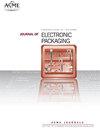Simplified and Detailed Analysis of Data Center Particulate Contamination At Server and Room Level Using CFD
IF 2.3
4区 工程技术
Q3 ENGINEERING, ELECTRICAL & ELECTRONIC
引用次数: 1
Abstract
Continuous rise in cloud computing and other web-based services propelled the data center proliferation seen over the past decade. Traditional data centers use vapor-compression-based cooling units that not only reduce energy efficiency but also increase operational and initial investment costs due to involved redundancies. Free air cooling and airside economization can substantially reduce the IT Equipment (ITE) cooling power consumption, which accounts for approximately 40% of energy consumption for a typical air-cooled data center. However, this cooling approach entails an inherent risk of exposing the IT equipment to harmful ultrafine particulate contaminants, thus, potentially reducing the equipment and component reliability. The present investigation attempts to quantify the effects of particulate contamination inside the data center equipment and ITE room using CFD. An analysis of the boundary conditions to be used was done by detailed modeling of IT equipment and the data center white space. Both 2-D and 3-D simulations were done for detailed analysis of particle transport within the server enclosure. An analysis of the effect of the primary pressure loss obstructions like heat sinks and DIMMs inside the server was done to visualize the localized particle concentrations within the server. A room-level simulation was then conducted to identify the most vulnerable locations of particle concentration within the data center space. The results show that parameters such as higher velocities, heat sink cutouts, and higher aspect ratio features within the server tend to increase the particle concentration inside the servers.基于CFD的数据中心服务器和机房颗粒污染的简化和详细分析
云计算和其他基于网络的服务的持续增长推动了过去十年中数据中心的激增。传统的数据中心使用基于蒸汽压缩的冷却单元,这不仅降低了能源效率,而且由于涉及冗余,增加了运营和初始投资成本。自由空气冷却和空侧节能可以显著降低IT设备(ITE)的冷却功耗,这大约占典型风冷数据中心能耗的40%。然而,这种冷却方法带来了IT设备暴露于有害超细颗粒污染物的固有风险,从而可能降低设备和部件的可靠性。本研究试图使用CFD量化数据中心设备和ITE室内颗粒物污染的影响。通过对IT设备和数据中心空白空间的详细建模,对要使用的边界条件进行了分析。为了详细分析服务器外壳内的颗粒传输,进行了二维和三维模拟。对服务器内的散热器和DIMM等主要压力损失障碍物的影响进行了分析,以可视化服务器内的局部颗粒浓度。然后进行了房间级模拟,以确定数据中心空间内粒子浓度最脆弱的位置。结果表明,服务器内较高的速度、散热器切口和较高的纵横比特征等参数往往会增加服务器内的颗粒浓度。
本文章由计算机程序翻译,如有差异,请以英文原文为准。
求助全文
约1分钟内获得全文
求助全文
来源期刊

Journal of Electronic Packaging
工程技术-工程:电子与电气
CiteScore
4.90
自引率
6.20%
发文量
44
审稿时长
3 months
期刊介绍:
The Journal of Electronic Packaging publishes papers that use experimental and theoretical (analytical and computer-aided) methods, approaches, and techniques to address and solve various mechanical, materials, and reliability problems encountered in the analysis, design, manufacturing, testing, and operation of electronic and photonics components, devices, and systems.
Scope: Microsystems packaging; Systems integration; Flexible electronics; Materials with nano structures and in general small scale systems.
 求助内容:
求助内容: 应助结果提醒方式:
应助结果提醒方式:


